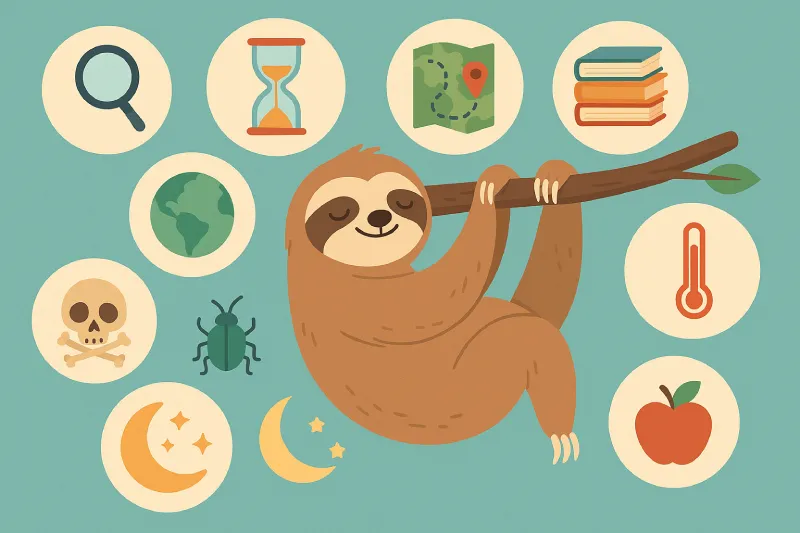naturepreservehub.com – Discover 10 interesting facts about sloths that you probably didn’t know! From their slow moves to surprising swimming skills, this article will have you loving these unique creatures even more.
If you’ve ever watched a sloth hanging lazily from a tree, you may have thought they were the definition of chill. But there’s a lot more to these slow-moving creatures than meets the eye.
From their unique physical traits to their surprisingly fascinating lifestyle, sloths are one of the most interesting animals out there. So, let’s dive into 10 interesting facts about sloths that will blow your mind!
Table of Contents
ToggleIntroduction to Sloths
Sloths are known for their laid-back nature, spending most of their lives hanging from trees in the rainforests of Central and South America. While they might look a bit awkward or even comical as they move at a glacial pace, these animals are highly adapted to their environment.
Their slow movements are actually a survival strategy that helps them conserve energy in a world where food is scarce and competition for resources is high.
They have a reputation for being one of the slowest mammals on Earth, but their slow pace comes with some truly remarkable features. If you’re ready to learn more about these gentle, tree-dwelling creatures, keep reading for 10 interesting facts about sloths that are sure to amaze you!
10 Interesting Facts About Sloths
1. Slow Movers
You’ve probably heard that sloths are slow, but just how slow are they? Sloths are so slow that their top speed on the ground is only about 0.03 miles per hour.
In the trees, they don’t move much faster—typically around 0.1 miles per hour. While this might sound like a disadvantage, it actually works in their favor. Their sluggish pace makes them harder for predators to spot, blending them in with the tree branches.
But don’t be fooled by their slow-moving nature—sloths can be surprisingly agile when they need to be, especially in the trees where they are most at home.
-
Sloths spend about 90% of their lives hanging upside down.
-
Their slow movements are a defense mechanism.
-
They conserve energy by moving slowly.
2. Three-toed vs. Two-toed
There are two main types of sloths: the three-toed sloth and the two-toed sloth. Despite their similar names, these two types are actually quite different from each other.
-
Three-toed sloths are more common and have a smaller, rounder face with a lighter fur color. They’re typically found in the rainforests of South America.
-
Two-toed sloths are a bit bigger and have longer arms. They are more commonly found in Central America and tend to have a darker, more rugged appearance.
Both types of sloths are unique in their own way, but they share a love for hanging out in the treetops and eating leaves all day long.
-
Three-toed sloths tend to be better swimmers than their two-toed relatives.
-
Two-toed sloths are generally more active on the ground but are still incredibly slow.
3. Surprising Swimmers
Despite their reputation for being slow on land, sloths are actually quite good swimmers. In fact, they are known to be able to hold their breath for up to 40 minutes underwater.
Sloths can use their long arms to paddle through the water, and they even enjoy swimming in the rainforests’ rivers and streams.
-
Sloths are not great on land, but their swimming skills are impressive.
-
Their ability to hold their breath for long periods is an adaptation to their aquatic lifestyle.
4. Algae-Green Fur
Sloths aren’t just known for being slow movers; they also have another cool characteristic—green fur! Their fur is home to a variety of algae that grows in the moist environment of the rainforests. This algae gives sloths their signature greenish tint, which helps them blend into the foliage.
But the algae isn’t just for camouflage. It also plays a crucial role in the sloth’s health. The algae provides sloths with a kind of “extra food source,” as the animals nibble on it while they groom themselves.
-
The algae in their fur helps them stay hidden from predators.
-
Their fur also provides a unique ecosystem for a variety of creatures.
5. Sleep a Lot
Sloths are some of the sleepiest animals around, snoozing for an average of 15–20 hours a day. This extensive sleep is necessary for conserving their energy, as they have a very slow metabolism.
By sleeping so much, sloths conserve energy and limit their need for food, which is often hard to come by in the treetops.
-
Sloths are some of the sleepiest creatures in the animal kingdom.
-
Their slow metabolism means they need a lot of rest to survive.
6. Low-Calorie Diet
Speaking of food, sloths are herbivores with a very low-calorie diet. They mostly eat leaves, which don’t provide a lot of energy. As a result, sloths have a very slow metabolism and only need to eat about one-third of their body weight in food each week. This low-calorie diet is perfect for their sedentary lifestyle, allowing them to conserve as much energy as possible.
-
Sloths eat leaves, which are low in calories and nutrients.
-
They can survive on a limited diet because of their slow metabolism.
7. Defensive Posture
Sloths may not seem very threatening, but they do have a defensive posture to protect themselves from predators. When threatened, a sloth will raise its arms to make itself appear larger.
This, combined with their slow, deliberate movements, can be enough to deter predators like jaguars and ocelots.
-
Sloths have sharp claws that can cause serious damage if needed.
-
Their defense strategy mainly relies on appearing unthreatening.
8. Solitary Creatures
Sloths are solitary animals. They prefer to live alone, only coming together for mating. In the wild, they spend most of their time in trees, moving from one branch to another, rarely interacting with others of their kind. This solitary lifestyle has contributed to their slow pace and relaxed way of living, as they don’t need to compete with other sloths for resources.
-
Sloths are not social creatures and prefer solitude.
-
They are known for being solitary except during mating season.
9. Weak Vision
Sloths have poor eyesight, a fact that contributes to their slow, deliberate movements. They rely more on their sense of smell and hearing to navigate the world around them.
Sloths have excellent hearing, which helps them detect predators and other dangers. Their weak vision doesn’t prevent them from living successfully in their environment, but it does make them more cautious.
-
Sloths rely on their sense of smell and hearing more than their vision.
-
Their poor eyesight makes them vulnerable to predators, but their cautious nature helps them survive.
10. They Can Hang Upside Down Forever
One of the most unique things about sloths is their ability to hang upside down for an indefinite amount of time. Their muscles and tendons are specially adapted for this posture, allowing them to conserve energy while clinging to branches without much effort.
In fact, sloths spend almost their entire lives hanging upside down, from eating to sleeping to moving around.
-
Sloths have special muscles that help them stay upside down.
-
They are perfectly adapted for life in the trees, where hanging upside down is the norm.
Conclusion
Sloths are fascinating creatures that deserve our admiration and protection. Their slow pace, unique physical traits, and surprising skills make them stand out in the animal kingdom.
Whether it’s their ability to swim, their defensive postures, or their algae-covered fur, sloths continue to capture our imaginations.
Next time you spot a sloth (or even just think about them), remember these 10 interesting facts about sloths and appreciate how perfectly adapted they are to their environment.
FAQs
Q: Do sloths really sleep all day?
A: Yes, sloths sleep between 15 and 20 hours each day. This helps them conserve energy and survive on their low-calorie diet.
Q: How fast can sloths move?
A: Sloths move at a top speed of about 0.03 miles per hour on the ground and a bit faster in trees. Their slow pace helps them stay hidden from predators.
Q: Why is sloth fur green?
A: The greenish tint in sloth fur is caused by algae that grow on their hair, helping them blend in with the foliage and providing a food source.
















